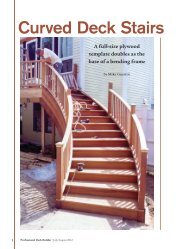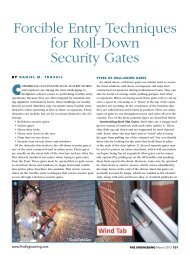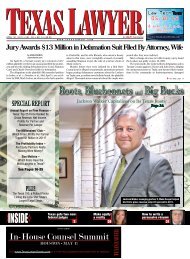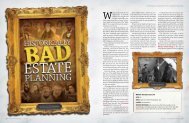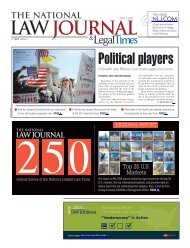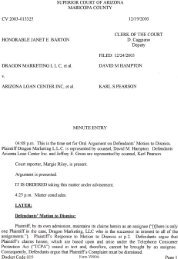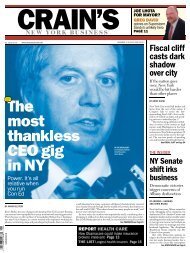ISN'T IT RICH? - American Business Media
ISN'T IT RICH? - American Business Media
ISN'T IT RICH? - American Business Media
You also want an ePaper? Increase the reach of your titles
YUMPU automatically turns print PDFs into web optimized ePapers that Google loves.
insurance companies were unfairly blaming the banks for the falloutfrom an unprecedented national housing market crash. Quinn EmanuelUrquhart & Sullivan’s Philippe Selendy, representing MBIA, retortedthat Countrywide wanted the judge to rule that the crisis was “a ‘getout-of-jail-free’card that allows them to escape liability for their fraudand shift the costs to innocent parties.”Three months later, on January 3, Justice Bransten largely sided withthe monolines. She ruled that MBIA and Syncora only needed to showthat they wouldn’t have insured the mortgage-backed securities if theyhad known about the alleged misrepresentations by Countrywide—now owned by Bank of America—in its mortgage securitizations. LikeBran sten’s other rulings in the monoline litigation, her decision providedammunition for monolines like Assured Guaranty Ltd. in theirown fights with the banks. (The decision is now on appeal.)At press time a settlement increasingly seemed the likely result inMBIA’s suit against Bank of America, which has its own pending suitagainst the monoline over the insurer’s 2009 restructuring, set for trial inMBIA and other monolines demanded that thebanks repurchase hundreds of thousands oftroubled mortgages. But the banks resisted.April. But even if MBIA and Bank of America make peace, another slewof suits—largely handled by firms such as Quinn Emanuel and PattersonBelknap Webb & Tyler—are still moving through the courts, and the riskof significant liability for the banks does not seem to be diminishing.The monolines’ progress so far contrasts with the struggles of regulatorsto hold Wall Street accountable for the excesses of the housingboom. Few criminal prosecutions have resulted from the subprimemeltdown. The Securities and Exchange Commission’s settlements withthe banks have drawn scrutiny from at least one judge, who questionswhether they went far enough. Class actions brought by investors inmortgage-backed securities have hit procedural roadblocks, and investorshave fought among themselves over whether the biggest settlementproposed so far related to their contractual mortgage repurchase claims,an $8.5 billion accord with Bank of America, is big enough.Amid the troubled lawsuits and investigations, will it be a groupof battered insurers who hold the banks accountable in court for thefinancial crisis?THE FIRST MONOLINES—known as such because they had justone line of business, backing bonds against possible defaults—were Ambac Financial Group, Inc., and Municipal Bond InsuranceAssociation (now MBIA), born in the early 1970s with the goalof insuring municipal bonds. Over time, the monolines came to includecompanies such as Assured Guaranty, XL Capital Assurance Inc. (nowSyncora), and CIFG Holding, Ltd., and they expanded their focus to insurestructured finance securities, including securities backed by mortgageson residential real estate. What began as a niche grew rapidlyduring the housing bubble of the 2000s.Then the bubble burst. When the mortgages in the securities soured,billions of dollars in claims by investor policyholders overwhelmed themonolines. By 2010 Ambac was paying out a reported $120 million amonth on claims related to mortgage-backed securities. As of September,MBIA had incurred losses of more than $4.6 billion. Assured Guarantysays it has paid out $2.5 billion net of reinsurance.The monolines’ own AAA credit ratings—crucial for reassuring munibond investors that the firms can pay out claims—vanished. In somecases, their ratings went to junk status. The insurers were forced to takedrastic steps. In February 2009 MBIA split into two separate companies:One entity would handle municipal bond insurance; the other tookthe troubled structured finance business. Ambac faced a similar fate.In March 2010 the insurer separated $64 billion in structured financepolicies into a segregated account at the order of Wisconsin insuranceregulators. Its holding company filed for Chapter 11 bankruptcy protectionin November 2010. Financial Guaranty Insurance Company,another monoline, filed for Chapter 11 in August 2010.(These moves didn’t go over well with the banks, which were tryingto collect on policies for their own mortgage-related investments.Eighteen banks brought in Sullivan & Cromwell to sue MBIA in May2009 for fraudulently conveying $5 billion in assets to its municipalbond arm. MBIA denies the claims and has since settled withall but four banks.)As more and more mortgage-backed securities went bad,monolines lawyered up to investigate the toxic investments.Court records show that in fall 2007, MBIA hired Weil, Gotshal& Manges and Cadwalader, Wickersham & Taft to adviseit on potential claims against Countrywide and ResidentialFunding Company LLC, the mortgage arm and securitizationsponsor of what is today Ally Financial Inc. As a party to thesecuritizations, MBIA had contractual rights under two separatesets of agreements: one that governed the securitizations’structure and another that covered how the insurance policies worked.Within those agreements lay a potential escape hatch to recover fromtheir losses. The documents provided for representations and warrantiesabout the mortgages being securitized, such as the homeowners’income, employment, and credit scores. The agreements also stipulatedthat if a mortgage did not meet those standards, a monoline or trusteecould demand that the bank buy back or replace the mortgage.The trick, then, was to figure out how many mortgages didn’t live upto the reps and warranties and needed “put-back,” as lawyers later cameto call the claim. Under its servicing and insurance agreements, MBIA’slawyers believed that the insurer had a right to demand access to theunderlying documents and mortgage files related to the securitizations.After MBIA gained what it says was limited access, consultants hiredto analyze samples of the mortgage files found big problems. WithResidential Funding, for example, reviews of 7,913 loan files found thatmore than 88 percent of the mortgages did not meet the standards describedin the contracts, according to MBIA’s later court filings.MBIA and the other monolines demanded that the banks repurchasehundreds of thousands of troubled mortgages. But the banks resisted.Some loans were still performing despite alleged breaches, which couldstem from missing paperwork. More fundamentally, the banks claimedthat the monolines had known exactly what they were insuring. BarryLevin, an Orrick, Herrington & Sutcliffe partner who representsCredit Suisse Group AG in suits by MBIA, Ambac, and Assured, callsthe monolines “extremely sophisticated” deal participants in the securitizationmachine who had access to all relevant information whenthey agreed to insure the securitizations. Yet by their own accounts, themonolines did no independent due diligence on the loans, relying insteadon what banks told them. “And now that the market has collapsed,they decided to try to shift their losses to others,” Levin says.MBIA sued Countrywide for fraud and breach of contract in NewYork state court on September 30, 2008, just two weeks after LehmanBrothers Holdings Inc. collapsed. The lawsuit was the first of many. InNovember 2008 Ambac launched a federal suit against an arm of Bear,Stearns & Co., Inc., now owned by JPMorgan Chase & Co. A monthlater MBIA sued Residential Funding after the insurer had alreadypaid out $264 million in claims to investors in five GMAC securitizations.By the beginning of 2012, another four monolines had joinedMBIA and Ambac in filing at least 32 lawsuits in federal and statecourts in New York, California, Washington, D.C., and Texas.ASMALL COTERIE OF FIRMS is representing the monolines.“There’s a fraternity of lawyers handling these cases onbehalf of the monoline plaintiffs, and we are in regularcontact to compare notes and share ideas,” says Jacob Buchdahl of SusmanGodfrey. While some of these firms, such as Debevoise & Plimpton,Cadwalader, and Kutak Rock, had transactional experience relatedto securitizations or to the monolines, more often the monolines haveturned to firms with few if any banking conflicts: Quinn Emanuel, PattersonBelkap, Susman Godfrey, and Boies, Schiller & Flexner.ORRICK’S BARRY LEVIN SAYSTHE MONOLINES DIDN’T DOTHEIR OWN DUE DILIGENCE ONSECUR<strong>IT</strong>IZED MORTGAGES.The lawsuits drew interest amonginvestors such as Manal Mehta, apartner at San Francisco-based hedgefund Branch Hill Capital. Mehta, aformer Morgan Stanley trader whodescribes himself as left-leaning, twoyears ago started buying stock first inMBIA and then in Assured Guaranty,after deciding that investing in themonolines was the surest way to profitfrom the banks’ mortgage-backedsecurities liabilities. “Two years ago,people said this wasn’t real, that theywere suing and weren’t going to recoveranything,” he says. But as favorablerulings have piled up, Mehta hasbecome more sure of his bet.The numbers in two Bank ofAmerica settlements—one with investorsand another with a monoline—alsoback Mehta’s hunch thatthe insurers are on track to land biggerrecoveries than other plaintiffs.Last June, Bank of America reachedan $8.5 billion settlement with investorsin private label mortgage-backedsecurities following negotiationsbetween Gibbs & Bruns, who representeda group of institutional investors,and the bank’s lawyers atWachtell, Lipton, Rosen & Katz.Lawyers for investors not at the negotiatingtable have since challenged thesettlement as too small; it equates tojust 4 cents on the dollar when comparedto the amount outstanding atthe time, $221 billion. In contrast,lawyers for Assured Guaranty at PattersonBelknap and Deb evoise helped their client land a settlementof at least $1.1 billion in April 2011 with BofA that was equal to 21percent of the $5.2 billion still owed by homeowners in the mortgagesecuritizations that Assured Guaranty had insured.With each court ruling, Mehta figures, the cost of settling increasesfor the banks. And there have been a lot of court rulings thatfavor the monolines.The first big decision came in July 2009. Justice Bransten largelydisregarded a motion by Countrywide to dismiss parts of MBIA’s suitaccusing it of fraud in misrepresenting which loans went into the securitizations.Her ruling had big reverberations. In the two years thatfollowed, state and federal judges in New York cited the decision andallowed several other suits by MBIA, Syncora, and Ambac allegingfraud to move forward against units of Ally Financial, Morgan Stanley,JPMorgan Chase, and Bank of America. Keeping the fraud claimsalive meant that the monolines not only could seek punitive damagesbut also potentially probe the business operations that allowed the allegedlyflawed loan processes in the first place.84 March 2012 | americanlawyer.comThe <strong>American</strong> Lawyer | March 2012 85



